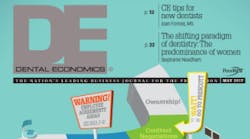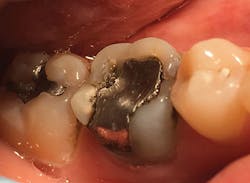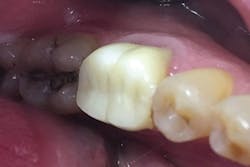Big money
It is time for dental professionals to realize the destructive effects of bruxism and how much damage it contributes to teeth, especially the "big-money teeth"—first molars, which are most commonly treated teeth in the mouth.
Let’s talk about money and teeth, especially the big-money tooth. There is one tooth that claims the title of the big-money tooth. It is by far the most commonly treated tooth in the mouth, there from when we are six years old. By now you should have guessed I am talking about the lower first molar. Nos. 19 and 30 are the most commonly treated teeth. You know how it happens. These teeth will often have deep pits and fissures early on and will require some type of small restoration. When I was in dental school, one restorative dentistry professor had a saying: “Every little filling will grow up to become a crown.”
Boy, was he right! That small filling eventually has to be replaced with something a little bigger and then perhaps something bigger—until a cusp breaks off and the tooth requires a crown. From there, many money teeth become sensitive and require endodontic therapy and a new crown. Many of these teeth go on to develop root fractures or secondary caries, making them nonrestorable. Then extraction is necessary. After that, nothing happens, or a bridge is placed that destroys the two teeth near it, or an implant is placed.
The big-money tooth usually then involves the upper first molar, and over time, the same scenario occurs again. How many patients do you see whose upper and lower first molars have opposing crowns? This happens because the lower first molar crown damages the upper first molar as a result of the patient’s bruxism. If the lower first molars become big-money teeth requiring restorations, those restorations can eventually turn into four crowns on all of the first molars and more.
Most dentists never step back to ask why this happens. Certainly, caries plays a role in this disease cascade—that is usually how the big-money tooth gets started. At some point, though, this is not only about caries. It is about dental material choices. It is certainly about bruxism.
Bruxism affects one out of three patients and is the most common dental disease that most dentists rarely address. Up to 265 pounds of force can be generated onto the first and second molars as people chew. This force is a result of the lower jaw being a Class I lever and the power of the masseter, temporalis, and medial pterygoid muscles working together to close the jaw. It is easy to understand why first molars are described as the big-money teeth. It is amazing that they ever survive!
My message to you is this: When you begin seeing big-money teeth crack, you need to ask yourself why it is occurring (as you should with any tooth, for that matter). Is it recurrent caries, new caries, a dental material failure, an undermined cusp from a previous restorative procedure, or bruxism? Most likely, it is a combination of a few factors, some of which you and I need to treat with a new restoration or crown.
Today we have an additional advantage in being able to treat and prevent the first molar from becoming the big-money tooth. We can now control the patient’s bruxism by treating the masticatory muscles with botulinum toxin (Botox or Xeomin), which will reduce the intensity of contraction and can even “cure” bruxism. The primary muscles being treated here are the masseter and temporalis muscles bilaterally.
Both patients and dentists are usually amazed at the amount of relief achieved and how much more relaxed the patient’s jaws feel. This, in turn, takes a lot of pressure off all the teeth, especially the big-money teeth, which will help save tooth structure long term.
Botox is a great tool to control bruxism and save teeth. It is time for dental professionals to realize the destructive effects of bruxism and how much damage it contributes to teeth.
Author’s note: Go to FacialEsthetics.org to sign up for a free monthly e-newsletter or to access information about live-patient Botox and dermal fillers training, frontline TMJ/orofacial pain training, frontline bruxism therapy, dental sleep medicine, and Medicare and medical insurance for every dental office.
Louis Malcmacher, DDS, MAGD, is a practicing general dentist and an internationally known lecturer and author. Dr. Malcmacher is the president of the American Academy of Facial Esthetics (AAFE) and a consultant for STATDDS. Contact him at (800) 952-0521 or [email protected].


